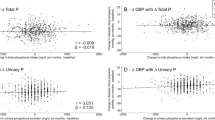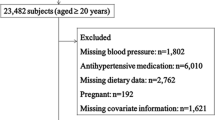Abstract
The relationship between calcium intake and hypertension is receiving increased research attention. The prevalence of hypertension is high among the obese populations. Calcium is a mineral that influences blood pressure. The aim of the study was to examine the association between calcium intake and hypertension in a large nationally representative sample of obese American adults. A total of 14 408 obese adults aged 20 years or older were obtained from the 1999–2010 National Health and Nutrition Examination Survey. Analysis of variance and linear regression models were used to examine relationships between calcium intake and systolic blood pressure (SBP) as well as diastolic blood pressure (DBP). Multiple logistic regression models were used to examine the association between calcium intake and hypertension after adjusting for potential confounders and interactions, including: age, race, education level, alcohol use, smoking, diabetes status, sodium intake and potassium intake. Calcium intake was significantly lower for the hypertensive group compared with the normotensive group (P<0.0001), especially among those obese female young adults aged 20–44 years and among non-diabetic obese adults. Based on ordinary linear regression analysis, a significant inverse relationship was detected, SBP and DBP decreased if calcium intake increased (SBP: regression coefficient estimate=−0.015, P<0.0001; DBP: regression coefficient estimate=−0.028, P<0.0001). Multiple logistic regression showed that calcium intake was negatively associated with the probability of hypertension (odds ratio (OR)=0.81, 95% confidence interval (CI): 0.74–0.87, P<0.0001). In stratified analysis, calcium intake in youngest adults (age 20–44 years) had the lowest likelihood of hypertension (OR=0.77, 95% CI: 0.64–0.93, P<0.0001), the inverse relationship between calcium intake and probability of hypertension was stronger among females (OR: 0.68, 95% CI: 0.55–0.84, P<0.0001), when compared with the whole sample including all of 14 408 obese adults. The protective effect of calcium intake and hypertension was found significantly in obese non-diabetic adults (OR: OR=0.77, 95% CI: 0.67–0.89, P<0.0001) not in obese diabetic adults. SBP, DBP and calcium intake were log transformed for both ordinary linear regression analysis and logistic regression analysis. Our study findings underscore the need to explore the physiological mechanism between calcium intake and hypertension. In this study, increased calcium intake was associated with the lowest risk of hypertension. Future studies utilizing longitudinal research designs are needed to quantify therapeutic levels of calcium for control of hypertension among obese adults. Increasing calcium intake among American adults may offer promise as a cost-effective strategy to improve hypertension among obese adults; however, further scientific exploration is warranted.
This is a preview of subscription content, access via your institution
Access options
Subscribe to this journal
Receive 12 digital issues and online access to articles
$119.00 per year
only $9.92 per issue
Buy this article
- Purchase on Springer Link
- Instant access to full article PDF
Prices may be subject to local taxes which are calculated during checkout

Similar content being viewed by others
References
Kochanek KD, Xu JQ, Murphy SL, Minino AM, Kung HC . Deaths: final data for 2009. Natl Vital Stat Rep 2011; 60: 3.
Peterlik M, Cross HS . Vitamin D and calcium deficits predispose for multiple chronic diseases. Eur J Clin Invest 2005; 35: 290–304.
Ruidavets JB, Bongard V, Simon C, Dallongeville J, Ducimetiere P, Arveiler D et al. Independent contribution of dairy products and calcium intake to blood pressure variations at a population level. J Hypertens 2006; 24: 671–681.
Snijder MB, van der Heijden AAWA, van Dam RM, Stehouwer CD, Hiddink GJ, Heine RJ et al. Is higher dairy consumption associated with lower body weight and fewer metabolic disturbances? The Horn Study. Am J Clin Nutr 2007; 85: 989–995.
Wang L, Manson JE, Buring JE, Lee IM, Sesso HD . Dietary intake of dairy products, calcium, and vitamin D and the risk of hypertension in middle-aged and older women. Hypertension 2008; 51: 1–7.
Engberink MF, Hendriksen MAH, Schouten EG, van Rooij FJA, Hofman A, Witteman JCM et al. Inverse association between dairy intake and hypertension: the Rotterdam Study. Am J Clin Nutr 2009; 89: 1877–1883.
Goran MI, Ball GD, Cruz ML . Obesity and risk of type 2 diabetes and cardiovascular disease in children and adolescents. J Clin Endocrinol Metab 2003; 88: 1417–1427.
Kannel WB, Brand N, Skinner JJ Jr, Dawber TR, McNamara PM . The relation of adiposity to blood pressure and development of hypertension. The Framingham study. Ann Intern Med 1967; 67: 48–59.
Wolf AM, Finer N, Allshouse AA, Pendergast KB, Sherrill BH, Caterson I et al. PROCEED: Prospective Obesity Cohort of Economic Evaluation and Determinants: baseline health and healthcare utilization of the US sample. Diabetes Obes Metab 2008; 10: 1248–1260.
Sugiyama T, Xie D, Graham-Maar RC . Dietary and lifestyle factors associated with blood pressure among U.S. adolescents. J Adolesc Health 2007; 40: 166–172.
Centers for Disease Control and Prevention. Overweight and Obesity: Adults Obesity Facts [Internet]. Centers for Disease Control and Prevention 2012 [updated 2012; cited 2013 Mar 6]. Available from http://www.cdc.gov/obesity/data/adult.html.
Finkelstein EA, Trogdon JG, Cohen JW, Dietz W . Annual medical spending attributable to obesity:payer- and service-specific estimates. Health Affairs 2009; 28: w822–w831.
Appel LJ, Brands MW, Daniels SR, Karanja N, Elmer PJ, Sacks FM . Dietary approaches to prevent and treat hypertension: a scientific statement from the American Heart Association. Hypertension 2006; 47: 296–308.
Sacks FM, Svetkey LP, Vollmer WM, Appel LJ, Bray GA, Harsha D et al. Effects on blood pressure of reduced dietary sodium and the dietary approaches to stop hypertension (DASH) diet. DASH-Sodium Collaborative Research Group. N Engl J Med 2001; 344: 3–10.
Appel LJ, Moore TJ, Obarzanek E, Vollmer WM, Svetkey LP, Sacks FM et al. A clinical trial of the effects of dietary patterns on blood pressure. DASH Collaborative Research Group. N Engl J Med 1997; 336: 1117–1124.
Gauci AA, Laaser U . Intersalt: an international study of electrolyte excretion and blood pressure. Results for 24 h urinary sodium and potassium excretion. Intersalt Cooperative Research Group. BMJ 1988; 297: 319–328.
Midgley JP, Matthew AG, Greenwood CM, Logan AG . Effect of reduced dietary sodium on blood pressure: a meta-analysis of randomized controlled trials. JAMA 1996; 275: 1590–1597.
Beilin LJ, Burke V, Cox KL, Hodgson JM, Mori TA, Puddey IB . Non pharmacologic therapy and lifestyle factors in hypertension. Blood Press 2001; 10: 352–365.
Van Leer EM, Seidell JC, Kromhout D . Dietary calcium, potassium, magnesium and blood pressure in the Netherlands. Int J Epidemiol 1995; 24: 1117–1123.
Streppel MT, Arends LR, van’t Veer P, Grobbee DE, Geleijnse JM . Dietary fiber and blood pressure: a meta-analysis of randomized placebo-controlled trials. Arch Intern Med 2005; 165: 150–156.
National Center for Health Statistics. The National Health and Nutrition Examination Survey (NHANES) 2001–2006 data files [Internet]. Centers for Disease Control and Prevention, National Center for Health Statistics 2008 [updated 2008; cited 2013 Mar 6]. Available from www.cdc.gov/nchs/about/major/nhanes/datalink.htm.
Expert Panel on Detection, Evaluation, and Treatment of High Blood Cholesterol in Adults. Executive Summary of the Third Report of the National Cholesterol Education Program (NCEP) Expert Panel on Detection, Evaluation, and Treatment of High Blood Cholesterol in Adults (Adult Treatment Panel III). JAMA 2001; 285: 2486–2497.
Alberti KG, Zimmet P, Shaw J . IDF Epidemiology Task: Force Consensus Group. The metabolic syndrome–a new worldwide definition. Lancet 2005; 366: 1059–1062.
Frohlich ED, Grimm C, Labarthe DR, Maxwell MH, Perloff D, Weidman WH . Recommendations for human blood pressure measurement by sphygmomanometer. Hypertension 1988; 11: 210A–222A.
Chobanian AV, Bakris GL, Black HR, Cushman WC, Green LA, Izzo JL Jr et al. The Seventh Report of the Joint National Committee on Prevention, Detection, Evaluation, and Treatment of High Blood Pressure: the JNC 7 report. JAMA 2003; 289: 2560–2572.
National Health and Nutrition Examination Survey. Exam procedures manual [Internet]. Centers for Disease Control and Prevention, National Center for Health Statistics 2004 [updated 2004; cited 2013 Mar 6]. Available from http://www.cdc.gov/nchs/nhanes/nhanes2003-2004/current_nhanes_03_04.htm.
Moshfegh AJ, Baer D, Cleveland L, Rhodes D, Sebastian R, Staples R et al. Validation of reported energy intakes in 24-hour dietary recalls using USDA automated multiple-pass method. The FASEB Journal 2003; 17: 281–282.
National Health and Nutrition Examination Survey. Exam procedures manual [Internet]. Centers for Disease Control and Prevention, National Center for Health Statistics 1999 [updated 1999; cited 2013 Mar 6]. Available from http://www.cdc.gov/nchs/nhanes/nhanes1999-2000/current_nhanes_99_00.htm.
Agricultural Research Service, Beltsville Human Nutrition Research Center, Food Surveys Research Group, Beltsville, MD [Internet]. USDA Food and Nutrient Database for Dietary Studies 2.0 [updated 2012; cited 2013 Mar 6]. Available from http://www.ars.usda.gov/ba/bhnrc/fsrg.
Agricultural Research Service, Beltsville Human Nutrition Research Center, Nutrient Data Laboratory, Beltsville, MD [Internet]. USDA National Nutrient Database for Standard Reference, Release 18 [updated 2012; cited 2013 Mar 6]. Available from http://www.ars.usda.gov/nutrientdata.
United State Census Bureau. Income, Poverty and Health Insurance in the United States: 2011 – Highlights. Poverty [Internet]. United State Census Bureau 2001 [updated 2012; cited 2013 Apr 26]. Available from http://www.census.gov/hhes/www/poverty/data/incpovhlth/2011/highlights.html.
National Health and Nutrition Examination Survey. The National Health and Nutrition Examination Survey (NHANES) Analytic and Reporting Guidelines [Internet]. Centers for Disease Control and Prevention, National Center for Health Statistics 2006 [updated 2006; cited 2013 Mar 6]. Available from http://www.cdc.gov/nchs/data/nhanes/nhanes_03_04/nhanes_analytic_guidelines_dec_2005.pdf.
National Health and Nutrition Examination Survey. Analytic Note Regarding 2007–2010 Survey Design Changes and Combining Data Across other Survey Cycles [Internet] Centers for Disease Control and Prevention, National Center for Health Statistics 2006 [updated 2011; cited 2013 Mar 6]. Available from http://www.cdc.gov/nchs/data/nhanes/analyticnote_2007-2010.pdf.
Ackley S, Barrett-Connor E, Suarez L . Dairy products, calcium, and blood pressure. Am J Clin Nutr 1983; 38: 457–461.
Gruchow HW, Sobocinski KA, Barboriak JJ . Alcohol, nutrient intake, and hypertension in US adults. JAMA 1985; 253: 1567–1570.
Harlan WR, Hull AL, Schmouder RL, Landis JR, Thompson FE, Larkin FA . Blood pressure and nutrition in adults. The National Health and Nutrition Examination Survey. Am J Epidemiol 1984; 120: 17–28.
McCarron DA . Calcium metabolism in hypertension. Keio J Med 1995; 44: 105–114.
McCarron DA, Morris CD, Henry HJ, Stanton JL . Blood pressure and nutrient intake in the United States. Science 1984; 224: 1392–1398.
Kromhout D, Bosschieter EB, Coulander CD . Potassium, calcium, alcohol intake and blood pressure: the Zutphen Study. Am J Clin Nutr 1985; 41: 1299–1304.
Kearney PM, Whelton M, Reynolds K, Muntner P, Whelton PK, He J . Global burden of hypertension: analysis of worldwide data. Lancet 2005; 365: 217–223.
Vasan RS, Beiser A, Seshadri S, Larson MG, Kannel WB, D’Aqostino RB et al. Residual lifetime risk for developing hypertension in middle-aged women and men: The Framingham Heart Study. JAMA 2002; 287: 1003–1010.
Torres M, Sanjuliani A . Does calcium intake affect cardiovascular risk factors and/or events? Clinics 2012; 67: 839–844.
Committee to Review Dietary Reference Intakes for Vitamin D and Calcium, Food and Nutrition Board, Institute of Medicine Dietary Reference Intakes for Calcium and Vitamin D. National Academy Press: Washington, DC, 2010.
Zemel MB . Calcium modulation of hypertension and obesity: Mechanisms and implications. J Am Coll Nutr 2001; 20 (suppl): 428S–435S.
Hoe SZ, Lee CN, Mok SL, Kamaruddin MY, Lami SK . Gynura procumbens Merr. decreases blood pressure in rats by vasodilatation via inhibition of calcium channels. Clinics 2011; 66: 143–150.
Author information
Authors and Affiliations
Corresponding author
Ethics declarations
Competing interests
The authors declare no conflict of interest.
Rights and permissions
About this article
Cite this article
Chen, Y., Strasser, S., Cao, Y. et al. Calcium intake and hypertension among obese adults in United States: associations and implications explored. J Hum Hypertens 29, 541–547 (2015). https://doi.org/10.1038/jhh.2014.126
Received:
Revised:
Accepted:
Published:
Issue Date:
DOI: https://doi.org/10.1038/jhh.2014.126



